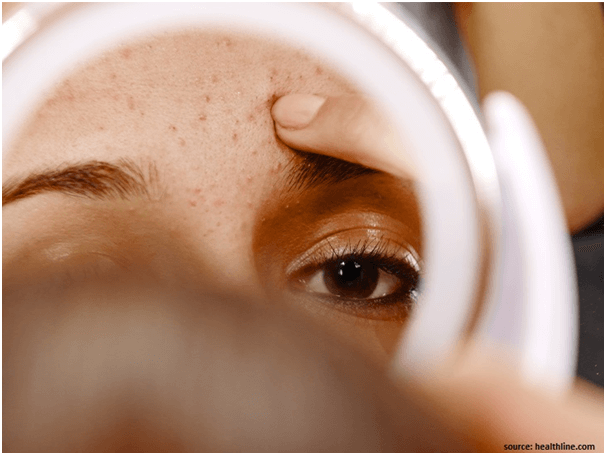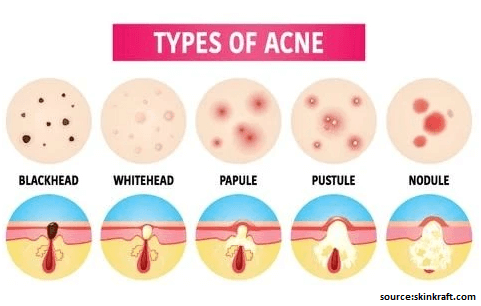Is Your Skin Acne-Prone? Create the Right Skin Routine For Yourself!
Is Your Skin Acne-Prone? Create the Right Skin Routine For Yourself!
Posted on October 6, 2020 at 4:00 PM

Taking care of acne-prone skin is more than just applying on blemish removing products. It involves lifestyle changes, too — the first of which begins with creating a new and improved skincare routine.
Let’s first begin with understanding the different types of acne:
Types of Acne

Acne is divided into non-inflammatory and inflammatory types:
-
Non-inflammatory :
Non-inflammatory acne refers to clogged pores that look like whiteheads or blackheads.
These are the mildest types and easy to spot. Blackhead appears dark and somewhat flat on the skin, whereas whiteheads are small skin-coloured bumps. -
Inflammatory :
Anything that looks red or more severe in appearance is usually classified as inflammatory acne. These include papules, pustules, nodules and cysts.
Papules appear as red bumps, whereas pustules appear as small bumps containing pus. Papules often become pustules over time.
There is also bigger acne, which are like inflamed bumps and appears larger than your usual pimple and feels as if they are under your skin.
How to Find your Skin Type?
People usually link oily skin to acne. After all, excess oil is a cause of breakouts. However, dry skin types can also experience acne; it might be due to environmental factors or a flawed skincare plan which irritates the skin and clogs pores.
If you do not know your skin type, follow these steps mentioned below:
- Step-1: Wash your face using mild baby soap, pat it dry. Do not apply any skincare products.
- Step-2: After some time, examine your skin. If it appears shiny, you have oily skin. If it is rough, flaky, or red, you have dry skin.
- Step-3: If your skin is a combination of oily and dry. It will appear dry on the cheeks and shiny on the chin, nose and forehead.
- Step-4: If you have normal skin, it will have a healthy glow with no problems.
Remember, no matter what your skin type, it is possible to be acne-prone without having dry or oily skin. A large number of people have had acne at least once in their lives.
Tips for Better Skin Care
Treating acne does not mean you use different products; it is about developing healthy skin no matter what your skin type. Follow some of these tips mentioned below for better skin:
- Wash your face when you wake up, and before you go to bed. However, doing it more than two times per day, unless you are especially sweaty, can irritate your skin.
- Be gentle with your face; do not scrub or use harsh exfoliants. It can lead to more redness and irritation.
- No popping and picking, it may be very tempting to pop your pimple, but doing so will lead to scarring and more pimples.
- Wash anything that comes in contact with your skin regularly like bedding, makeup brushes, and phone screens. They contain debris which could block your pores.
- Choose non-comedogenic products for your skin. However check the full ingredients of any face product you purchase, even if it says non-comedogenic or oil-free. Avoid anything that has potential irritants, like alcohol or fragrance.
- Keep your skin hydrated. It can combat the excess oil that causes acne. Drinking at least eight glasses of water per day is a good way to start.
Beginner Skin Care Routine
It would help if you planned the right skincare routine for your skin type; otherwise, you would end up with more problems.
Here’s every step you can take while dealing with acne-prone skin.
Morning
- Cleanser: Skin cleansing in the morning can be a good step for acne-prone skin.
- Toner: Use a toner to remove excess oil that may lead to breakouts.
- Moisturizer: Using a moisturizer will keep your skin hydrated no matter oily or dry.
- Sunscreen: If you are taking some acne treatments, they can increase your skin’s sensitivity to sunlight. Use a broad-spectrum, SPF 30 sunscreen to protect your skin.
- Makeup: Even though this tip is not essential, but makeup can quickly cover your pimples and residual redness.
Evening
- Makeup remover: If you decided to wear makeup, use a makeup remover to make sure your pores are correctly unclogged.
- Cleanser: Wash your face thoroughly after the day is done. Remove all the grime and dirt.
- Spot treatment: Using spot treatment after cleansing can allow it to work their way deep into your skin. It can treat existing pimples and stop new breakouts.
Extra touch-ups
- Exfoliant: Exfoliate your face once or twice a week to remove dead skin cells which can block pores and cause breakouts.
- Face mask: They can combat oiliness, hydrate dry skin and reduce redness; use at least three times a week for best results.
When to See a Dermatologist?
Mild acne can generally be treated with the help of over-the-counter medications. However, if it does not improve, you can consider consulting a dermatologist.
For acne that is moderate or severe, like cystic acne, or any acne that is scarring your skin. These require prescription medications.
Patience is key when dealing with acne. Use an acne and scar treatment plan for at least 1 month before changing it to a new one. Most treatments require 3 months before seeing any significant difference.
If you do not see any improvements consider switching to a new product or consider visiting Dr. Firdous one of the best dermatologist in Secunderabad for personalized consulting. No matter which route you take, follow the instructions consistently for the best possible outcome.
